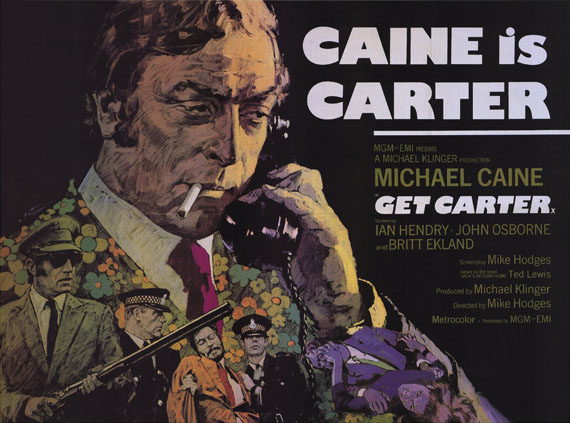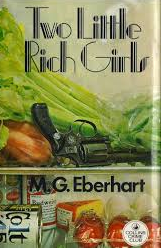
‘You’re a big man, but you’re in bad shape. With me it’s a full time job. Now behave yourself.’
If my Mr U. N. Owen-style pre-recorded message goes to plan, this message should be going out at exactly 00.01 UK time. Happy New Year everyone! I hope 2015 is good to you.
I’m kicking off this year with a round-up of posts from around the blogosphere, all featuring books first published in 1971, as part of last month’s challenge. As usual, apologies if I missed your entry…
I’m always delighted when I spot a relevant post ‘in the wild’, in other words not shared at the sign-up page. At the opening of the month, blogger/noir aficionado Pulpcurry shared a collection of ephemera from the 1971 British film Get Carter:
While it is by no means the best British crime movie ever made, as some would claim, it is a good one and has been very influential, in terms of plot, characterisation and visual feel.
 It would be graceless not to include a P. D. James this month, even if the review was published a little earlier than December. Moira at Clothes in Books revisited Shroud for a a Nightingale, highlightng the horror behind James’ polite prose.
It would be graceless not to include a P. D. James this month, even if the review was published a little earlier than December. Moira at Clothes in Books revisited Shroud for a a Nightingale, highlightng the horror behind James’ polite prose.
Of all the many many crime stories I have read, and all the gruesome and revolting ways of committing murder I have taken on board, this is the one that gives me bad dreams, because it is so homely and then so horrendous: the poison is going to be introduced into a young woman’s stomach via the gastric feed.
And what a horrible cover. But just when I thought I had seen enough skulls in hats…
… Jose Ignacio at The Game’s Afoot read Reginald Hill’s An Advancement of Learning, the second Dalziel (I still can’t bring myself to pronounce that properly) and Pascoe novel. It’s not only a 1971 book, but for bonus points it also has Christmassy overtones.
Superintendent Andy Dalziel and Sergeant Peter Pascoe have been called in to investigate the discovery of a body under a memorial at Holm Coultram College of Liberal Arts and Education. The monument was built to honour the memory of the former principal, Miss Alison Girling (1916 – 1966) who died at an avalanche in Austria during her Christmas holidays, although her remains were never found. The corpse recently discovered shows clear signs of having been murdered and was probably buried some five years ago. But soon, much to everyone’s surprise, the body can be identified positively as that of Alison Girling.
 Sticking with academic mysteries, Bev at My Reader’s Block ended a long quest to locate a copy of Edward Candy’s Words for Murder Perhaps.
Sticking with academic mysteries, Bev at My Reader’s Block ended a long quest to locate a copy of Edward Candy’s Words for Murder Perhaps.
Words is set at Bantwhich University. Gregory Roberts is a mild-mannered academic who teaches in the “Extra-Mural” (aka “adult education”) department. He’s middle-aged, living with his mother after his marriage dissolved and puttering along teaching little old ladies all about literature. The old dears love his new class, “Crime Fiction, Past and Present,” and little realize that a crime wave is about to hit the university.
 Bev also read Douglas Clark’s Sick to Death, the 5th in the series of Masters and Green police procedurals, but one which goes back to the team’s first case.
Bev also read Douglas Clark’s Sick to Death, the 5th in the series of Masters and Green police procedurals, but one which goes back to the team’s first case.
Green doesn’t quite trust Masters’ apparent ease with forensic specialists and his seemingly random methods of questioning suspects and following up leads. Masters thinks Green trusts police routine a little too much. They haven’t quite figured out how well they complement each other even as their methods seem to be in competition.
 The Puzzle Doctor, who was responsible for selecting 1971 as December’s year, read the Inspector Wexford mystery No More Dying Then as part of a Ruth Rendell month at In Search of the Classic Mystery Novel.
The Puzzle Doctor, who was responsible for selecting 1971 as December’s year, read the Inspector Wexford mystery No More Dying Then as part of a Ruth Rendell month at In Search of the Classic Mystery Novel.
Difficult one, this one. The mystery is rather clever, making perfect sense and yet still being surprising. I didn’t spot the killer and yet it is logical and also resonates with the real characters that generally populate Rendell’s work. You can tell there’s a but coming, can’t you…
You’ll have to follow the link to see the Doctor’s but. As Bart Simpson would say. I do apologise.
 Meanwhile, Curt at The Passing Tramp reviewed a later-period Mignon Eberhart, Two Little Rich Girls:
Meanwhile, Curt at The Passing Tramp reviewed a later-period Mignon Eberhart, Two Little Rich Girls:
In the 1970s newspaper reviews of her books increasingly would refer to Eberhart’s books, which always seemed to focus on the rich and privileged, as out-of-date and hackneyed. Some of this represented the tenor of the times, which were rather hostile to things deemed “traditional” in mystery, but it’s only to be expected that a writer in her seventies who had been churning out a book of year for decades might lose some of her plotting oomph.
 Back over to The Game’s Afoot, where Jose Ignacio read Ed McBain’s Hail, Hail, the Gang’s All Here. The title is explained by the book’s structure:
Back over to The Game’s Afoot, where Jose Ignacio read Ed McBain’s Hail, Hail, the Gang’s All Here. The title is explained by the book’s structure:
The action unfolds during twenty-four hours in the life of the Precinct, has multiple plots, and each one has a different detective in the leading role.
You have to love McBain’s titles. Telling it like it is.
From police procedural to suspense…
 John at Pretty Sinister Books chose L. P. Davies’ Give Me Back Myself, an amnesia novel in which everybody thinks accident victim Steven Dusack is one David Orme, except for Steven himself.
John at Pretty Sinister Books chose L. P. Davies’ Give Me Back Myself, an amnesia novel in which everybody thinks accident victim Steven Dusack is one David Orme, except for Steven himself.
At Orme’s massive estate protected by electronic gates and a gun toting chauffeur Stephen’s identity crisis plunges into a nightmare world of conspiracy, paranoia and murder attempts… The manner in which Stephen and his two allies slowly uncover the plot is done with ingenuity and a few startling surprises.
 Tracy at Bitter Tea and Mystery selected the only thriller to appear this month: from Victor Canning, the first of his ‘Birdcage’ books featuring the shady UK government organisation the Department:
Tracy at Bitter Tea and Mystery selected the only thriller to appear this month: from Victor Canning, the first of his ‘Birdcage’ books featuring the shady UK government organisation the Department:
…both a hunt for missing documents and a psychological study of a man who is very hardened to killing people (just in his line of work, as he sees it) but is seeking revenge for the murder of his lover. The story is primarily told from his point of view, and the reader learns of his childhood influences and how he became a member of the Department.
 Moira’s choice, Daphne du Maurier’s Don’t Look Now caused me some confusion on my quest for first edition covers – until I read her review again and realised it was originally called Not After Midnight in the UK. Tantalisingly…
Moira’s choice, Daphne du Maurier’s Don’t Look Now caused me some confusion on my quest for first edition covers – until I read her review again and realised it was originally called Not After Midnight in the UK. Tantalisingly…
Considered as a 1971 book – it has one considerable credential, but unfortunately I can’t even hint at it without spoilering the story. There is a feature which was to become remarkably relevant and current soon after publication. Cannot say more.
 And just scraping in to 2014, Col’s Criminal Library issued Death Wish author Brian Garfield’s What of Terry Conniston?, which sounds like one I’d quite like to read after a year of fairly polite crime-reading.
And just scraping in to 2014, Col’s Criminal Library issued Death Wish author Brian Garfield’s What of Terry Conniston?, which sounds like one I’d quite like to read after a year of fairly polite crime-reading.
Verdict – good, in fact probably very good but not great. We have a gang of musicians turning to crime and in short order graduating from petty thefts to kidnapping a tycoon’s daughter.
Thanks everyone for contributing! For January I have decided to make an executive decision and select my own year. The #1915book sign-up page will go live shortly…




1971 was obviously a very good year for crime books! 🙂
LikeLike
Great stuff Rich, thanks as ever for hosting, and looking forward to next month – did I see mention of 1915 on the way here? Intriguing….
LikeLike
Thanks, Rich, for hosting and this is a great group of books. I am glad to see that I am not the only one with problems with pronouncing Dalziel. I am doing a bit better after watching a few of the TV episodes.
LikeLike